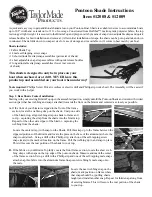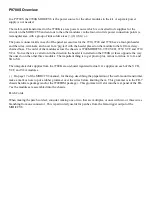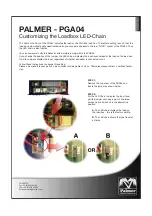
108
Appendix
—Owner’s Manual
Glossary
This section explains the technical terms used in this owner’s manual.
ATRAC
—An acronym for Adaptive Transform Acoustic Coding. This is the compression
technique used to fit the same amount of data as that of a 120 mm CD on a 64 mm MiniDisc.
Using the ATRAC system, the MD4S provides an 4-track recording time of 37 minutes.
ATRAC uses established psychoacoustic principles to compress audio data to approximately
one-fifth of its original size, with virtually no loss in sound quality. The threshold of hearing
principle states that the sensitivity of the human ear is frequency dependent. Two tones of the
same level but at different frequencies will not be heard at the same loudness. Another princi-
ple used is the masking effect. That is, softer sounds become inaudible when louder sounds at
similar frequencies are present.
Bus
—A “bus” is a route for audio signals to which the signal from each input channel can be
distributed, and which can be sent to its own output jack. The MD4S has the following buses.
ST bus
: Input channel signals are mixed in stereo to the stereo bus, and output from the STE-
REO OUT jacks.
CUE bus
: Signals from each input channel and the track playback are mixed in stereo to the
Cue bus, and output from the MONITOR OUT jacks and the PHONES jack. The output sig-
nal of this bus is mainly used to monitor signals during recording.
AUX bus
: Signals from each input channel are mixed in monaural to the AUX buses, and
output from the AUX OUT jacks. The output signal of these buses are mainly used as sends to
external effect processors, etc.
Clipping
—The unwanted distortion effect of overloading an audio circuit with a signal that
is too large. Care must be taken when setting the MD4S GAIN controls so as not to overload
the recording circuits. See “Recording the first track (Direct Recording)” on page 26.
Cue List
—The Cue List function allows you to compile a cue list (i.e., a sequence of cues for
playback) using markers. Cues are loaded into memory for continuous, uninterrupted play-
back. A new song can be created from the Cue List using the Cue List Copy function. See “Cue
List playback” on page 68 for more information.
DAT
—An acronym for Digital Audio Tape. DAT recorders are especially popular in recording
studios for recording the final stereo mix.
EQ
—An acronym for an audio equalizer. The MD4S input channels feature three-band EQ.
Foot switch
—A foot operated switch. Several MD4S transport functions and the punch in/
out function can be controlled using an optional footswitch.
Frame
—An integral unit of the MD DATA disc format. One frame can hold 11.6 ms of data
(i.e., 512 samples of ATRAC sound data at 44.1 kHz). There are approximately 86 frames in a
second. Using the FrameDisp function you can select between 86 (MD) and 30 (MTC) frames
per second.
Input channel
—An “input channel” is a section of the mixer that individually processes an
input signal. After a signal is input to an input channel, it is sent through the EQ to adjust its
tone, its volume level is adjusted, and then it is routed to a variety of output jacks.
Locate
—To “locate” means to move to a specific point in the song. The MD4S provides a
variety of Locate functions that allow you to jump instantly to the desired location. See “Quick
search functions” on page 61 for more information.
MD DATA
—A compact data storage medium designed to store computer-type data.
Although similar to MiniDiscs, they are not interchangeable. MD DATA discs come in two
varieties: playback only and rewritable. MD4S uses the rewritable type for recording. See
“Buying discs for the MD4S” on page 10 for more information.








































